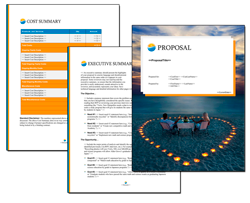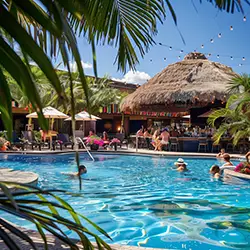
Best Tips on How to Write a Travel or Tourism Business Proposal
Learn how to write a travel or tourism business proposal that secures funding, management approval, or client agreements. This guide covers important steps and key components tailored to the travel industry. As a broad topic, different parts of this article will apply to different proposals. Regardless of the angle of your pitch and its purpose, your proposal can still be created using Proposal Kit.
Key Takeaways
- A travel proposal is important for articulating your vision, securing funding, and showcasing your company's unique identity.
- Key components of a successful proposal include a cover letter, a reader-focused section, detailed descriptions, and a credibility section.
- Proposal Kit can streamline the proposal writing process, helping you create professional, visually appealing documents efficiently.
Understanding the Purpose of a Travel or Tourism Business Proposal
Every journey begins with a clear purpose, and writing a travel or tourism business proposal is no different. At its core, the primary purpose of a travel proposal is to describe a vision in writing to land a client, secure funding, or get management approval. Whether you're seeking to launch a new tour package, expand your travel agency, or attract investors for a new destination, a well-written proposal is your key to unlocking these opportunities.
A travel proposal serves multiple important functions. It helps secure funding, gain management approval, and sell travel experiences. But beyond these, it also showcases your company's identity and values, providing a window into what makes your services unique. Conveying the type of travel offered and the company's commitment to service care transforms a travel agency proposal into a powerful tool for any travel agency proposal template.
For business travel proposals, the focus shifts slightly. These business proposals emphasize addressing the company's needs and highlighting potential returns on investment for prospective clients. Understanding the client's needs involves assessing the services offered and their added value, ensuring that the business travel proposal aligns perfectly with the client's expectations within the sales process.
Understanding these purposes, it's time to examine the key components contributing to a proposal's success.
What is a Sales Proposal for Tourism?

A sales proposal for tourism is a document that outlines a travel agency's services and packages to potential clients. It plays an important role in the sales process, accounting for a significant portion of a client's final decision. A well-written sales proposal can increase customer satisfaction and excitement about a travel experience. At the same time, a poorly written one can result in lost business and negatively impact the agency's brand. Therefore, understanding how to write a travel business proposal that resonates with prospective clients is important for success in the tourism industry.
The use of proposals for the travel industry is a very broad topic and can mean many different things. Pitching a business client on a joint venture is very different than a proposal to a lender to fund a travel-related startup. However, they can all be created using the same system and approach. When we talk about the client, that could also mean the reader, such as an executive to an internal project, is being pitched.
Key Components of a Successful Proposal
Creating a successful travel proposal involves more than just putting ideas on paper. It requires a structured approach that presents your vision clearly and persuasively. A good proposal typically begins with a clear introduction outlining the structure and key objectives. This sets the stage for the reader, providing a roadmap of what to expect.
The proposal should also include a reader-focused section tailored to the target audience's needs and interests. This section is crucial as it aligns the proposal with the client's expectations, enhancing the chances of approval. Detailed financial overviews, including cost estimates and revenue projections, are important to attract investment and demonstrate the proposal's viability.
Equally important is the credibility section, where you establish your ability to fulfill promises through past experiences and successes. By incorporating these key components, you can create a narrative that presents your vision and convinces the reader of its feasibility and potential for success.
Cover Letter
The first item in any proposal package should be the Cover Letter. This introductory document sets the stage for the entire proposal, providing a brief overview of who you are, the reason for submitting the proposal, and your contact information. Think of it as your first impression - it's your chance to capture the reader's attention and establish a professional connection.
A well-written cover letter should be concise yet informative, summarizing the proposal's key points and highlighting the client's benefits. Beyond stating facts, it involves creating a narrative that resonates with the reader and compels further reading. This is where you can build the trust and interest to carry through the rest of the proposal.
Reader-Focused Section

Addressing the client's needs is a cornerstone of any successful travel proposal. This section should include an executive summary that outlines the proposal's main points and explains how the proposed travel plan will benefit the recipient. Focusing on the client's needs demonstrates an understanding of their priorities and concerns, significantly enhancing the chances of approval.
This section should include pages like Needs and Benefits. These pages clarify expectations for management and travelers, ensuring alignment on trip objectives. A well-written reader-focused section persuades management to approve work-related travel and ensures all parties agree regarding the trip's goals and benefits.
Detailed Description Section
A detailed description section is where you get into the nitty-gritty of the travel proposal. Detailed trip information strengthens the case for management approval by clearly showing what the trip entails. This section should feature a detailed itinerary outlining daily activities and logistics to ensure a comprehensive travel plan.
Moreover, a detailed itinerary pricing schedule is crucial, clearly outlining all costs associated with the proposed trips. Pages describing services offered, products, costs, timeline, venues, facilities, tours, destinations, transportation, relationships, customers, and advertising should all be included to provide a thorough overview of the travel plan.
Credibility Section
Building trust with your proposal audience is important, and that's where the credibility section comes in. This section should include the company's history and the team's travel industry experience to build trust. Mentioning the length of experience, such as 12 years, emphasizes expertise and reliability.
Mentioning the types of clients served, such as businesses, groups, and individuals, showcases the agency's versatility and reliability. Including testimonials and awards received by the agency can further enhance credibility and affirm the services' value.
Collectively, these topics work to demonstrate the agency's credibility in the travel industry.
Visual Appeal and Branding

First impressions matter in the field of travel proposals. Incorporating your company logo into the proposal enhances brand recognition and adds a professional touch. Adding visual elements like colored borders and custom bullet points can create a unique visual appeal that aligns with your brand identity.
Consistency in design topics across the proposal is crucial. Maintaining a consistent typography that aligns with your brand's personality while ensuring legibility can make your proposal stand out. Using visually striking topics, such as a pop of color, can highlight key information and create visual interest, making the proposal more engaging.
Moreover, clean designs with ample space improve readability and professionalism while integrating shapes can create a distinctive look that supports effective cross-platform branding. Focusing on visual appeal and branding makes your proposal informative and visually captivating.
While Proposal Kit does have travel-related visual design themes, the Professional edition of the software allows you to build custom branded design themes using your background images, logos, fonts, and color schemes. The entry-level Proposal Kit software with every Proposal Pack has basic branding features, such as setting the color scheme and importing your logo into the front cover. However, once a proposal document is created, it is a Word format document you can customize using all of its features.
Using Proposal Kit for Travel Proposals
Proposal Kit is a powerful tool designed to streamline the proposal writing process. This product includes topic pages, examples, suggestions, and templates specifically tailored for travel and tourism proposals, providing a comprehensive selection to help you get started quickly. Proposal Kit allows you to create a professional-looking proposal that meets industry standards efficiently.
One significant advantage of using Proposal Kit is its support for custom branding. You can incorporate your logos and designs into the templates, enhancing your proposal's visual appeal and consistency. Additionally, Proposal Kit's organized structure and templates can significantly reduce the time spent writing proposals, allowing you to focus on the content and strategy.
You can add your content to Proposal Kit's stock templates so your edited versions are built into each new proposal. This is just one of many customizing features of the Proposal Kit software for optimizing proposal creation. The software also includes customizable line-item databases for building quotes, estimates, budgets, schedules, etc.
Here are some related samples included in every downloadable Proposal Pack
The AI Writer generates a first draft of these templates - customized to your company, client, and project - in just minutes, giving you a head start on editing. Get any Proposal Pack or Proposal Kit Professional, and all of these samples, and the AI Writer are included.
Here are some related downloadable templates
The AI Writer generates a first draft of these templates - customized to your company, client, and project - in just minutes, giving you a head start on editing. Get any Proposal Pack or Proposal Kit Professional, and all of these templates and the AI Writer are included.
Step-by-Step Guide to Writing a Travel Proposal
Writing a travel proposal can seem daunting, but with a structured approach, it becomes manageable. The first step is to research and define clear objectives for your project. Understanding potential visitors' demographics, preferences, and needs tailors the proposal to better meet the audience's expectations.
Next, develop a detailed plan that includes all necessary components, such as infrastructure development, marketing strategies, budget allocation, timeline, milestones, deliverables, and a management team. The plan should provide a clear picture of the project and ensure all stakeholders are aligned on expectations.
Finally, presenting your proposal is crucial. Highlighting its economic and social benefits, including job creation, revenue generation, and community development, can make your proposal more compelling. Data and visuals can strengthen your arguments and make the content more engaging.
Research and Define Objectives

A successful travel proposal starts with thorough research and clear objectives. Understanding your target audience and market is important, as it informs the direction and content of the proposal. Researching demographics tailors the proposal to meet the audience's preferences and expectations, increasing its chances of success.
Equally important is defining clear objectives. These objectives guide the proposal's direction and effectiveness, ensuring that every topic aligns with your goals. Thorough market research and well-defined objectives are critical to a successful travel proposal.
Develop a Detailed Plan
The next step involves creating a detailed plan. This plan should cover all necessary components, including infrastructure development, marketing strategies, budget allocation, timeline, milestones, and deliverables. A tour proposal should include specific elements, including a detailed itinerary, transport, accommodation, catering, and particular activities.
It is crucial to clearly outline the project budget and timeline and capture key information using custom fields. Additionally, outlining milestones and deliverables ensures all stakeholders are aligned on project expectations, providing a clear roadmap for success.
Trip Overview
A trip overview is a vital section in any travel agency proposal, providing a snapshot of the itinerary, destinations, and activities included in the package. This section should be tailored to the client's needs, desires, and budget to meet their expectations. A well-written trip overview should encompass the following elements:
- Destination(s) and Duration: Clearly state the destinations included in the trip and the duration of the stay at each location.
- Type of Travel: Specify whether the trip is for leisure, business, adventure, or another purpose.
- Activities and Experiences: Detail the planned activities and experiences, such as sightseeing tours, cultural events, and outdoor adventures.
- Accommodation Options: Provide information on available accommodations, such as hotels, resorts, and bed and breakfasts.
- Transportation Arrangements: Outline the transportation options, including flights, car rentals, and transfers.
By including these topics, you can create a comprehensive and appealing trip overview that captures the client's interest and aligns with their travel goals. These might be used in a proposal pitching an event or vacation plans to a client.
Presenting Your Proposal

Presenting your proposal can make all the difference. Highlighting its financial and social benefits, such as job creation, revenue generation, and community development, can make it more compelling. Detailing how the proposal contributes to local employment and community welfare strengthens your case. These might be used in a travel proposal designed around improving or building a location as a tourism or travel destination.
Supporting data and visuals are also crucial. They strengthen your arguments and make the proposal more engaging and accessible. Effective presentation increases your proposal's chances of approval and success.
Adding Value to Your Proposal
Adding value to your proposal is important to differentiate your travel agency from competitors and increase the likelihood of securing the client's business. Here are some effective strategies to enhance your proposal:
- Personalized Services: Offer tailored services that cater to the client's interests and preferences, demonstrating attention to detail and a commitment to providing a unique experience.
- Exclusive Experiences: Include unique and exclusive experiences not readily available elsewhere, adding a special touch to the travel package.
- Additional Services: Provide extra services such as travel insurance, visa assistance, and concierge services to offer a comprehensive travel solution.
- Flexible Payment Options: Offer various payment plans and competitive pricing to accommodate different budgets and financial situations.
- Expertise and Knowledge: Highlight your agency's expertise and in-depth knowledge of the destination(s), showcasing your ability to provide an exceptional travel experience.
By incorporating these topics, you can create a travel agency proposal that stands out and appeals to prospective clients.
Available Add-ons and Services
Enhancing the client's travel experience with available add-ons and services can significantly increase the value of your proposal and boost your agency's revenue. Here are some examples of valuable add-ons and services you can offer:
- Travel Insurance: Protects clients against unforeseen circumstances such as trip cancellations, medical emergencies, and lost luggage, providing peace of mind.
- Visa Assistance: This service helps clients navigate the often complex process of obtaining visas for international travel, ensuring a smooth and hassle-free experience.
- Concierge Services: Offers personalized assistance and recommendations for activities, restaurants, and attractions, enhancing the overall travel experience.
- Car Rentals: Provides convenient and affordable transportation options, allowing clients to explore their destination at their own pace.
- Travel Guides: Supplies clients with expert knowledge and insights about the destination(s), enriching their travel experience with valuable information.
Offering these add-ons and services enhances the client's travel experience and positions your agency as a comprehensive, customer-focused service provider.
Common Mistakes to Avoid
Even the best proposals can fall short if common mistakes are not avoided. One frequent challenge is balancing service assessment and pricing. Overloading the proposal with too much detail can also be a pitfall. Consider placing additional documents in appendices to avoid this.
Using software solutions for trip proposals can help automate sales document creation, save time, and reduce errors. This increases efficiency and improves the overall quality of the proposal, enhancing its chances of success.
Knowing these common mistakes, you can create a more compelling travel proposal.
Practical Examples of Travel Proposals

Seeing practical examples can provide valuable insights into creating your travel proposal. For instance, bed and breakfast proposals often emphasize creating a unique guest experience rather than merely offering accommodation. This approach helps differentiate the proposal and attracts clients looking for a memorable stay.
Eco-lodge proposals typically include details on sustainability initiatives and eco-friendly practices to attract environmentally-conscious investors. Joint venture proposals in the travel sector highlight mutual benefits and shared resources to entice potential partners.
These examples illustrate how different travel proposals and related templates can be tailored to meet specific goals and attract the right audience.
Finalizing Your Proposal
Finalizing your proposal requires meticulous attention to detail and a thorough review to ensure it is polished and professional. Here are some tips to help you finalize your proposal:
- Proofread Thoroughly: Review the proposal multiple times to catch any grammar, spelling, or accuracy errors. Use an online spelling and grammar checker to help proof your proposal.
- Ensure Visual Appeal: Make sure the proposal is visually appealing and easy to read, using consistent typography and design topics.
- Clear and Concise Writing: Use a clear and concise writing style to convey your message.
- Include All Necessary Information: Ensure all relevant information and supporting documents are included in the proposal.
- Professional Tone: Maintain a professional tone and language throughout the proposal to establish credibility and trust.
By following these tips, you can create a well-written proposal that leaves a positive impression and increases the chances of approval.
Terms and Agreement
The terms and agreement section is an important part of the proposal, outlining the travel agency's and client's obligations and responsibilities. It should include the following elements:
- Payment Terms and Conditions: Clearly state the payment terms, including due dates, accepted payment methods, and any penalties for late payments.
- Cancellation Policy and Refund Terms: Outline the conditions under which the client can cancel the trip and the terms for any refunds.
- Travel Insurance and Liability: Detail the travel insurance options available and the extent of the agency's liability in case of unforeseen events.
- Client Responsibilities and Obligations: Specify the client's responsibilities, such as providing necessary documentation and adhering to travel schedules.
- Agency Responsibilities and Obligations: Define the agency's responsibilities, including ensuring the quality of services and addressing any issues that may arise.
Including a clear and comprehensive terms and agreement section helps prevent misunderstandings and ensures that both parties are aware of their obligations, contributing to a smooth and successful travel experience.
By incorporating these sections into your travel agency proposal, you can create a comprehensive and compelling document that increases the chances of securing the client's business and providing a memorable travel experience.
 Proposal Kit Professional provides the most content, including legal contracts and a free design theme pack. Plus, advanced software features include custom branding and customizable quoting databases.
Proposal Kit Professional provides the most content, including legal contracts and a free design theme pack. Plus, advanced software features include custom branding and customizable quoting databases. Proposal Pack for Any Business covers this type of proposal and includes samples. There are also some commonly used specialty design themes available:
Proposal Pack for Any Business covers this type of proposal and includes samples. There are also some commonly used specialty design themes available:Photo Design Proposal Packs
Summary
In summary, writing a travel or tourism business proposal involves understanding its purpose, including key components, enhancing visual appeal, and avoiding common mistakes. Following a structured approach and using tools like Proposal Kit, you can create a proposal that secures funding and approval or lands a new client.
A well-written proposal not only presents your vision but also convinces the reader of its feasibility and potential for success. With the right strategy and attention to detail, you can turn your travel ideas into reality and attract the support you need.
Frequently Asked Questions
What is the purpose of writing a travel or tourism business proposal?
Writing a travel or tourism business proposal is all about clearly outlining your vision to get funding or approval from management or securing a client. It's your chance to show what makes your idea unique and worth investing in.
What should be included in the reader-focused section of a proposal?
Your proposal should highlight the Needs and Benefits, clearly explaining how it will address the recipient's concerns and add value for them. This will make it more relatable and show that you understand their priorities.
What are common mistakes to avoid in travel proposal writing?
To create a successful travel proposal, avoid overloading it with excessive details and ensure you find the right balance between service assessment and pricing. Also, consider using software tools like Proposal Kit to save time and minimize errors.
How can the Proposal Kit help write travel proposals?
Proposal Kit can simplify your travel proposal writing by offering tailored templates, examples, and suggestions that streamline the process. You'll find everything you need to create a professional proposal with ease!
What should the first item in a proposal package be?
The first item in your proposal package should be a Cover Letter that introduces you, explains the purpose of your proposal, and includes your contact information. This sets a professional tone right from the start.



 Cart
Cart
 Are you just looking for a template, sample, or software for your travel and tourism proposals? Click these links to skip down the page and get right to it.
Are you just looking for a template, sample, or software for your travel and tourism proposals? Click these links to skip down the page and get right to it.















 Facebook
Facebook YouTube
YouTube Bluesky
Bluesky Search Site
Search Site